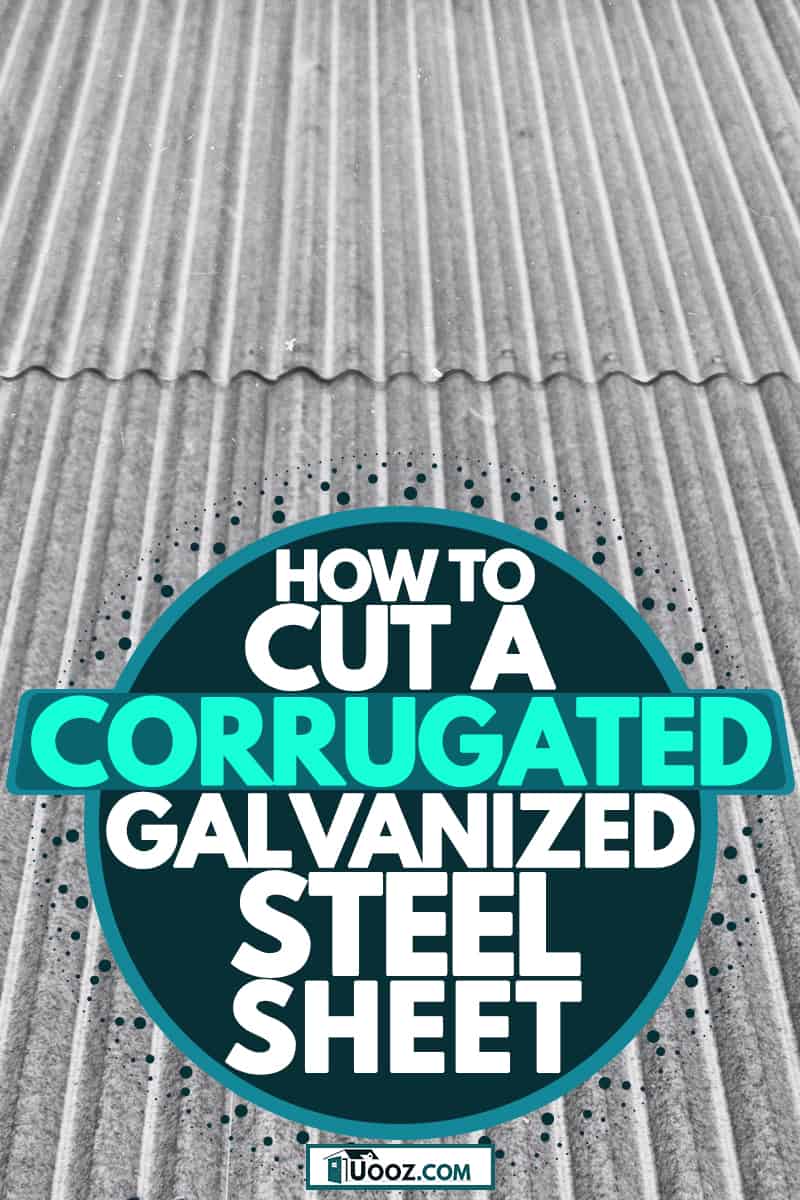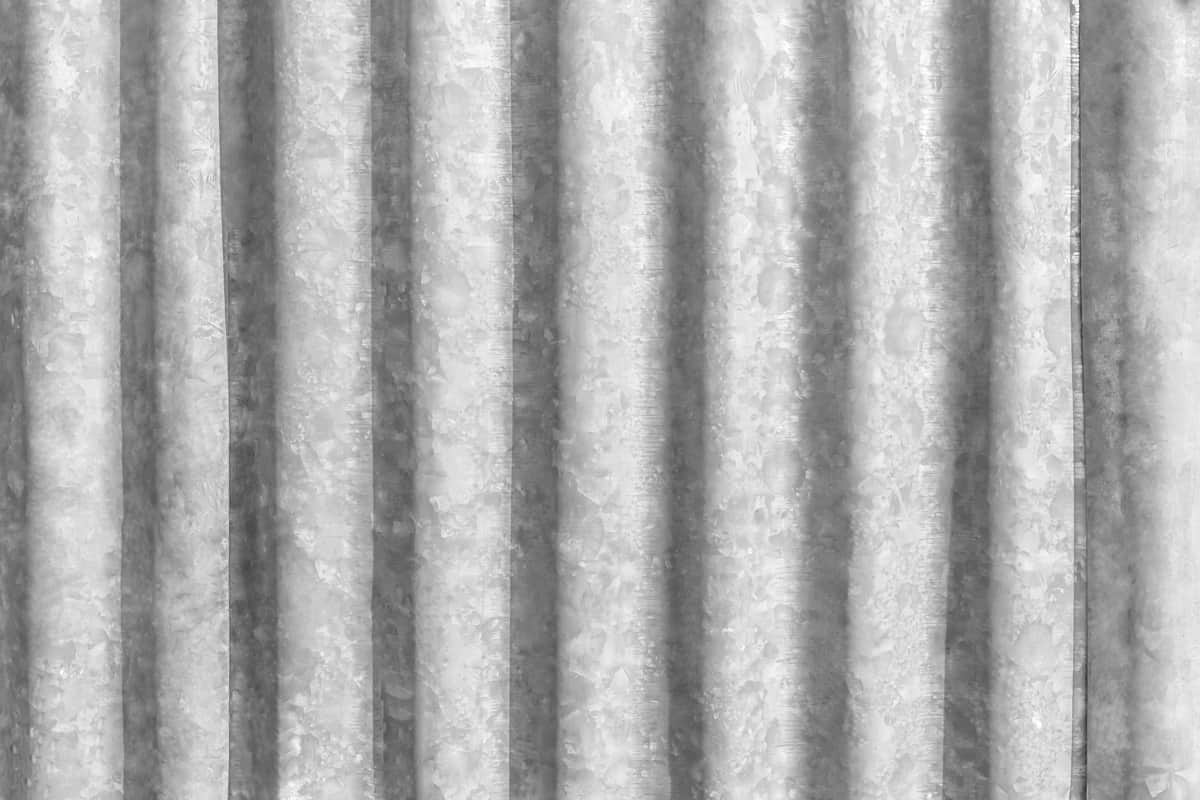Corrugated galvanized steel sheets present unique cutting challenges. Corrugated describes the wavy ridges. Galvanized represents the zinc layer utilized to strengthen and provide rust resistance. Each of these properties contributes to the metal sheet cutting considerations. We consulted galvanizer, metalworker, home improvement, and government sources to find the best and safest corrugated galvanized steel sheet cutting recommendations.
No matter the tool or method utilized, cutting corrugated galvanized steel sheets involves the following basic steps:
- Gather needed tools.
- Put on personal protective equipment (PPE).
- Clamp steel sheet to a sturdy work surface.
- Measure and mark the sheet metal.
- Cut using the chosen method.
- Smooth edges.
Corrugated galvanized steel sheets are lightweight, fireproof, and durable, making them good for indoor and outdoor home projects. Cutting a corrugated galvanized steel sheet presents edge smoothing, rust prohibition, fume creation, and metal debris consideration. Keep reading to discover suggestions for cutting this special combination of corrugation and zinc.

1. Gather needed tools
Sheet metal is measured in gauges. Gauge measurements vary for different types of metal. No matter the material you are using, the lower the gauge, the thicker the sheet. You will need to make sure the tool and any attachments you select are rated to cut the corrugated galvanized steel sheet gauge properly.
Ensure you have a sturdy well-lit workspace. You will want a work surface large enough to easily hold your sheet metal as you measure, mark, and cut—select clamping, measurement, and marking implements.
2. Put on Personal Protective Equipment (PPE)
Safety is always a metal cutting project consideration. Metal cutting fumes, sharp edges, and particles require eye, hand, body, breathing, and foot protection. Additional protection is needed when utilizing power tools. Per the Occupational Safety and Health Administration (OSHA), personal protective equipment (PPE) may help avoid galvanized steel cutting safety hazards like metal or zinc chloride fumes, burns, cuts, and eye damage.
Safety Glasses
Some safety glasses are clear to allow inside or outside transitions while blocking glare and eye health issues.
Check out these Dewalt Safety Glasses at Amazon.
Ear Safety
When using any type of power tool, safety earmuffs or earplugs will help guard against hearing loss.

Check out the AmazonBasics Ear Protection at Amazon.
Safety Gloves
Look for safety gloves that protect from cuts and abrasion but allow you to maintain the needed grip to handle your tools and materials securely.
Check out the Schwer Cut-Resistant Mesh Glove at Amazon.
Safety Work Apron
A safety work apron allows for body protection from metal tools and materials. Keep the apron properly secured to avoid errant entanglement with power tools.
Check out this Holulo Kevlar Cut-Resistant Apron at Amazon.
Safety Sleeves
Protect your arms from cuts and burns using safety sleeves.
Check out these Superior Glove Cut-Resistant Sleeves at Amazon.
Safety Mask (Respirator)
Utilize a safety mask to avoid metal fumes and dust while cutting sheet metal.

Check out this 3M Respirator at Amazon.
3. Clamp sheet to a sturdy work surface
Place the corrugated galvanized steel sheet, underside up, on a steady workbench. The underside of the sheet provides a flatter working surface than the top-side ridges. Verify the work surface is large enough for measuring, marking, and cutting the sheet metal.
Clamp the corrugated galvanized steel sheet to the work surface with one or more vises. Ensure the number of vises used and vise strength are sufficient to hold the sheet metal in place without shifting.

Check out the Forward Bench Vise from Amazon.
4. Measure and mark
A flat, sturdy surface increases measuring and marking precision. Use a tape or laser measure to determine measurements. Mark measurements along the edges of the steel sheet with a permanent marker, pencil, or scratch awl. Use a chalk line or T-Square with your chosen marking instrument to connect cutting lines from the measured marks.
Check out the Ludwig Precision T-Square at Amazon.
5. Cut using the chosen method
A battery-operated tool may provide needed power convenience or cord freedom for your sheet metal cutting project. Ensure your tool purchase contains the battery and charger, that you have a compatible battery, or that you purchase the correct battery. You can often select the tool as a kit with battery, blades, toolbag, or other tool-specific needs. Follow manufacturer instructions and recommendations for tool use.
Can You Cut Corrugated Galvanized Steel With A Grinder?
An angle grinder provides a good cutting method for corrugated galvanized steel sheets. Hold the grinder with both hands and start with a smooth light grinding motion to ensure you have a firm grasp on the cutting process and tool.
Check out this Makita Cordless Angle Grinder Kit on Amazon.
An abrasive metal cutting grinder disc will cut corrugated galvanized steel sheets; however, a diamond blade will cut more quickly without losing blade diameter.
Check out this Graff Diamond Metal Cutting Wheel at Amazon.
Can A Dremel Cut Corrugated Galvanized Steel?
Dremel brand rotary tools with metal cutting wheels allow cutting by moving along the facing surface. Ensuring you have the sheet metal securely clamped will allow you to manage the Dremel properly with both hands.
Check out this Dremel Rotary Tool with Accessory Kit at Amazon.
Use a rotary tool metal cutting disc to achieve the best results.
Check out the Dremel Metal Cutting Disc at Amazon.
What Is The Best Tool To Cut Sheet Metal?
While manual options, such as heavy-duty snips or a hacksaw, provide inexpensive sheet metal cutting options, the process may be slow, labor-intensive, or leave jagged edges. Powered versions of nibblers or shears provide a quicker and smoother finish.
Nibblers
A nibbler provides a clean, quick cut with reduced edge rust on corrugated galvanized steel sheets. Nibbling refers to the speedily-punched micro pieces ‘nibbled’ through metal. Nibbler cuts do not damage the sheet metal or coatings; however, the cut lines are thicker than other cutting tools.
The nibbler is a more expensive tool that may render it cost-prohibitive if the need is for one small project. The right-angle format allows nibblers to cut straight and curved lines easily. Nibblers leave smoother and safer metal edges than other metal-cutting tools; however, you will want to smooth any rough edges that remain.

Check out the Makita Cordless Nibbler at Amazon.
Small metal chips (nibblets) produced during the cutting process may abrade the sheet metal or the cutting floor. A magnetic roller or pickup tool will assist with cleanup.

Check out the Grip Magnetic Pickup Floor Sweeper at Amazon.
Metal Shears
Metal shears allow you to position on the cut line and cut with the press of a button. Though a speedy way to cut, metal shears require deliberate cutting. Hasty cuts may cause the shears to become stuck in the sheet metal.
The better shear option is a pair of double-cut metal shears. These work with a powered scissor (or shear) cut action. Double-cut metal shears have two cutters that remove a metal strip, leaving a flat smooth cut edge.
Single-cut metal shears have a fixed blade and a cutting blade. While single-cut shears do not remove the metal strip, they are not as flexible or edge-smoothing as double-cut shears.

Check out the Makita Cordless Straight Shear at Amazon.
6. Smooth edges
Burrs are small rough metal teeth left at the edge of cut metal. Cut sheet metal may also have very sharp edges. Cut metal edges require deburring and edge smoothing for safety and functionality.
How Do You Smooth The Edges Of Corrugated Metal?
You may use sandpaper or a metal hand file to smooth corrugated metal edges. If you are using an angle grinder for the project, a flap disk will remove burrs and sharp edges. If you are using a Dremel, utilize a polishing tool to smooth cut edges.
The Architect of the Capitol (AOC) sheet metal specialists utilize a deburring tool to remove the sharp edges and burrs of cut metal. The deburring tool reduces injuries.

Check out the AFA Tooling Deburring Tool at Amazon.
Does Cut Corrugated Galvanized Steel Rust?

Corrosion is a breakdown of metal caused by surface oxygen exposure. Rust is a form of corrosion that occurs on unprotected metal. Galvanization protects corrugated steel from rust; however, the galvanization may be removed from the edges when the sheet metal is cut.
The Metal Roofing Alliance (MRA) advises that galvanized chemical structure provides a ‘self-healing’ process; however, the galvanized coating will be thinner in cut areas. Any corrosion that occurs on the cut edges is based on the level of zinc and the environment in which the steel sheet is used.
While rust may deter from the appearance, it will not diminish the structural fidelity of the corrugated galvanized steel sheet. Thicker sheets will provide a larger area susceptible to rust when cut.
Summary
Multiple power and manual options are available for cutting a corrugated galvanized steel sheet. Always utilize the appropriate PPE to provide both tool and sheet metal handling safety. Use a sturdy work surface, carefully measure and mark, and work steadily to ensure safe and accurate cuts.
You may also be interested in reading some of our related posts about metal roofing:









